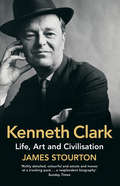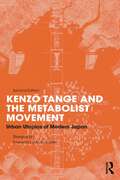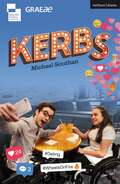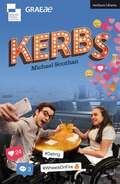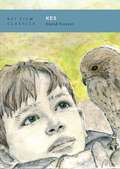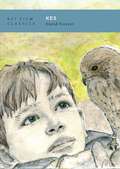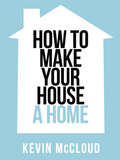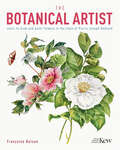- Table View
- List View
Ken Loach: The Politics of Film and Television
by NA NAJohn Hill's definitive study looks at the career and work of British director Ken Loach. From his early television work (Cathy Come Home) through to landmark films (Kes) and examinations of British society (Looking For Eric) this landmark study reveals Loach as one of the great European directors.
Ken Smith Landscape Architect: Urban Projects (Source Books in Landscape Architecture #2)
by Nicola BednarekKenneth Clark: Life, Art And Civilisation
by James StourtonSHORTLISTED FOR THE BERGER PRIZE FOR BRITISH ART HISTORY 2017 SHORTLISTED FOR THE SLIGHTLY FOXED BEST FIRST BIOGRAPHY PRIZE 2017 A SUNDAY TIMES ART BOOK OF THE YEAR A SPECTATOR BOOK OF THE YEAR AN ECONOMIST BOOK OF THE YEAR A NEW YORK TIMES ART BOOK OF THE YEAR
Kenneth Lonergan: Filmmaker and Philosopher (Philosophical Filmmakers)
by Todd MayKenneth Lonergan's three films-You Can Count on Me (2000), Margaret (2011), and Manchester by the Sea (2016)-are rife with philosophical complexities. They challenge simple philosophical approaches to central issues of human behaviour. In particular, they ask questions about how to cope with suffering that one cannot overcome, the role that self- deception plays in people's lives and how to think about characters who do not embody simplistic moral ideas of virtue and vice. By philosophically engaging with these themes as they unfold in Lonergan's films, we are then able to formulate a more nuanced answer to the questions they pose. Kenneth Lonergan: Philosophical Filmmaker will draw from Lonergan's films and plays, along with the philosophical literature on the topics that they explore. The rich history of philosophical reflection surrounding these areas enables the reader to determine how the themes central to Lonergan's work have combined to create a rich cinematic oeuvre.
Kenneth Lonergan: Filmmaker and Philosopher (Philosophical Filmmakers)
by Todd MayKenneth Lonergan's three films-You Can Count on Me (2000), Margaret (2011), and Manchester by the Sea (2016)-are rife with philosophical complexities. They challenge simple philosophical approaches to central issues of human behaviour. In particular, they ask questions about how to cope with suffering that one cannot overcome, the role that self- deception plays in people's lives and how to think about characters who do not embody simplistic moral ideas of virtue and vice. By philosophically engaging with these themes as they unfold in Lonergan's films, we are then able to formulate a more nuanced answer to the questions they pose. Kenneth Lonergan: Philosophical Filmmaker will draw from Lonergan's films and plays, along with the philosophical literature on the topics that they explore. The rich history of philosophical reflection surrounding these areas enables the reader to determine how the themes central to Lonergan's work have combined to create a rich cinematic oeuvre.
Kenosis Creativity Architecture: Appearance through Emptying (Routledge Research in Architecture)
by Randall S. LindstromKenosis Creativity Architecture locates and explores creativity’s grounding in the ancient concept of kenosis, the “emptying” that allows creativity to happen; that makes appearance possible. It concretises that grounding through architecture—a primal expression of human creativity—critically examining, for the first time, kenotic instantiations evidenced in four iconic, international projects; works by Kahn, Pei, Ando, and Libeskind. Then, in a final turn, the potentiality of architecture’s own emptying is probed. Architect and author Randall Lindstrom draws on Western and Eastern philosophy, including that of Heidegger, Levinas, Derrida, Vattimo, Nishida, and Nishitani, as well as on the theology of Christianity, Judaism, and aspects of Buddhism, Hinduism, and Islam. Every chapter expands the argument that, if responsiveness to our world is taken seriously—if proper and sustainable responses are to be realised—then a deeper understanding of creativity, and so kenosis, is essential. This book opens-up a way of thinking about creativity and humanity’s readiness to be creative. It thereby presents a crucial enquiry—at the nexus of architecture, philosophy, and theology—for researchers, graduate and postgraduate students, and practitioners alike.
Kenosis Creativity Architecture: Appearance through Emptying (Routledge Research in Architecture)
by Randall S. LindstromKenosis Creativity Architecture locates and explores creativity’s grounding in the ancient concept of kenosis, the “emptying” that allows creativity to happen; that makes appearance possible. It concretises that grounding through architecture—a primal expression of human creativity—critically examining, for the first time, kenotic instantiations evidenced in four iconic, international projects; works by Kahn, Pei, Ando, and Libeskind. Then, in a final turn, the potentiality of architecture’s own emptying is probed. Architect and author Randall Lindstrom draws on Western and Eastern philosophy, including that of Heidegger, Levinas, Derrida, Vattimo, Nishida, and Nishitani, as well as on the theology of Christianity, Judaism, and aspects of Buddhism, Hinduism, and Islam. Every chapter expands the argument that, if responsiveness to our world is taken seriously—if proper and sustainable responses are to be realised—then a deeper understanding of creativity, and so kenosis, is essential. This book opens-up a way of thinking about creativity and humanity’s readiness to be creative. It thereby presents a crucial enquiry—at the nexus of architecture, philosophy, and theology—for researchers, graduate and postgraduate students, and practitioners alike.
Kenzo Tange and the Metabolist Movement: Urban Utopias of Modern Japan
by Zhongjie LinMetabolism, the Japanese architectural avant-garde movement of the 1960s, profoundly influenced contemporary architecture and urbanism. This book focuses on the Metabolists’ utopian concept of the city and investigates the design and political implications of their visionary planning in the postwar society. At the root of the group’s urban utopias was a particular biotechical notion of the city as an organic process. It stood in opposition to the Modernist view of city design and led to such radical design concepts as marine civilization and artificial terrains, which embodied the metabolists’ ideals of social change. Tracing the evolution of Metabolism from its inception at the 1960 World Design Conference to its spectacular swansong at the Osaka World Exposition in 1970, this book situates Metabolism in the context of Japan’s mass urban reconstruction, economic miracle, and socio-political reorientation. This new study will interest architectural and urban historians, architects and all those interested in avant-garde design and Japanese architecture.
Kenzo Tange and the Metabolist Movement: Urban Utopias of Modern Japan
by Zhongjie LinMetabolism, the Japanese architectural avant-garde movement of the 1960s, profoundly influenced contemporary architecture and urbanism. This book focuses on the Metabolists’ utopian concept of the city and investigates the design and political implications of their visionary planning in the postwar society. At the root of the group’s urban utopias was a particular biotechical notion of the city as an organic process. It stood in opposition to the Modernist view of city design and led to such radical design concepts as marine civilization and artificial terrains, which embodied the metabolists’ ideals of social change. Tracing the evolution of Metabolism from its inception at the 1960 World Design Conference to its spectacular swansong at the Osaka World Exposition in 1970, this book situates Metabolism in the context of Japan’s mass urban reconstruction, economic miracle, and socio-political reorientation. This new study will interest architectural and urban historians, architects and all those interested in avant-garde design and Japanese architecture.
Kenzo Tange and the Metabolist Movement: Urban Utopias of Modern Japan
by Zhongjie LinAmid Japan’s political turbulence in 1960, seven architects and designers founded Metabolism to propagate radical ideas of urbanism. Kenzō Tange’s Plan for Tokyo 1960 further celebrated urban expansion as organic processes and pushed city design to an unprecedented scale. Metabolists’ visionary schemes of the city gave birth to revolutionary design paradigms, which reinvented the discourse of modern Japanese architecture and propelled it through the years of Economic Miracle to a global prominence. Their utopian concepts, which often envisaged the sea and the sky as human habitats of the future, reflected fundamental issues of cultural transformation and addressed environmental crises of the postindustrial society. This new edition expands Zhongjie Lin’s pathbreaking account on Tange and Metabolism centered at the intersection of urbanism and utopianism. The thorough historical survey, from Metabolism’s inauguration at the 1960 World Design Conference to the apex of the movement at Expo ’70 and further to the recent demolition of Nakagin Capsule Tower, leads to a definition of three Metabolist urban paradigms – megastructure, group form, and ruins – which continue to inspire experiments in architecture, city design, and conservation. Kenzō Tange and the Metabolist Movement is a key book for architectural and urban historians, architects, and all those interested in avant-garde design, Japanese architecture, and contemporary urbanism.
Kenzo Tange and the Metabolist Movement: Urban Utopias of Modern Japan
by Zhongjie LinAmid Japan’s political turbulence in 1960, seven architects and designers founded Metabolism to propagate radical ideas of urbanism. Kenzō Tange’s Plan for Tokyo 1960 further celebrated urban expansion as organic processes and pushed city design to an unprecedented scale. Metabolists’ visionary schemes of the city gave birth to revolutionary design paradigms, which reinvented the discourse of modern Japanese architecture and propelled it through the years of Economic Miracle to a global prominence. Their utopian concepts, which often envisaged the sea and the sky as human habitats of the future, reflected fundamental issues of cultural transformation and addressed environmental crises of the postindustrial society. This new edition expands Zhongjie Lin’s pathbreaking account on Tange and Metabolism centered at the intersection of urbanism and utopianism. The thorough historical survey, from Metabolism’s inauguration at the 1960 World Design Conference to the apex of the movement at Expo ’70 and further to the recent demolition of Nakagin Capsule Tower, leads to a definition of three Metabolist urban paradigms – megastructure, group form, and ruins – which continue to inspire experiments in architecture, city design, and conservation. Kenzō Tange and the Metabolist Movement is a key book for architectural and urban historians, architects, and all those interested in avant-garde design, Japanese architecture, and contemporary urbanism.
Kerbs (Modern Plays)
by Michael SouthanIt doesn't have to be anything more than it is. Let's just be… organic.Lucy and David are dating. Or at least, they're trying to.Faced with first-date disasters, a few crossed wires and Lucy's mum, what they really need is a bit of space, a bitof fun – and ideally some independence. Escaping for the weekend to a caravan park in Somerset, it's time for them to find out if their spark will finally catch, or burn everything to the ground.Written by Graeae's Write to Play graduate Michael Southan, Kerbs gets real about romance, sex and disability, while tackling the universal challenge faced by anyone experiencing a new relationship: letting someone in.A Graeae and Belgrade Theatre coproduction for Coventry UK City of Culture 2021.
Kerbs (Modern Plays)
by Michael SouthanIt doesn't have to be anything more than it is. Let's just be… organic.Lucy and David are dating. Or at least, they're trying to.Faced with first-date disasters, a few crossed wires and Lucy's mum, what they really need is a bit of space, a bitof fun – and ideally some independence. Escaping for the weekend to a caravan park in Somerset, it's time for them to find out if their spark will finally catch, or burn everything to the ground.Written by Graeae's Write to Play graduate Michael Southan, Kerbs gets real about romance, sex and disability, while tackling the universal challenge faced by anyone experiencing a new relationship: letting someone in.A Graeae and Belgrade Theatre coproduction for Coventry UK City of Culture 2021.
Kernel Learning Algorithms for Face Recognition
by Jun-Bao Li Shu-Chuan Chu Jeng-Shyang PanKernel Learning Algorithms for Face Recognition covers the framework of kernel based face recognition. This book discusses the advanced kernel learning algorithms and its application on face recognition. This book also focuses on the theoretical deviation, the system framework and experiments involving kernel based face recognition. Included within are algorithms of kernel based face recognition, and also the feasibility of the kernel based face recognition method. This book provides researchers in pattern recognition and machine learning area with advanced face recognition methods and its newest applications.
Kes (BFI Film Classics)
by David ForrestKen Loach's 1969 drama Kes, considered one of the finest examples of British social realism, tells the story of Billy, a working class boy who finds escape and meaning when he takes a fledgling kestrel from its nest.David Forrest's study of the film examines the genesis of the original novel, Barry Hines' A Kestrel for a Knave (1968), the eventual collaboration that brought it to the screen, and the film's funding and production processes. He provides an in depth analysis of key scenes and draws on archival sources to shed new light on the film's most celebrated moments. He goes on to consider the film's lasting legacy, having influenced films like Ratcatcher (1999) and This is England (2006), both in terms of its contribution to film history and as a document of political and cultural value. He makes a case for the film's renewed relevance in our present era of systemic economic (and regional) inequality, alienated labour, increasingly narrow educational systems, toxic masculinity, and ecological crisis. Kes endures, he argues, because it points towards the possibility for emancipation and fulfilment through a more responsive and nurturing approach to education, a more delicate and symbiotic relationship with landscape and the non-human, and an emotional articulacy and sensitivity shorn of the rigid expectations of gender.
Kes (BFI Film Classics)
by David ForrestKen Loach's 1969 drama Kes, considered one of the finest examples of British social realism, tells the story of Billy, a working class boy who finds escape and meaning when he takes a fledgling kestrel from its nest.David Forrest's study of the film examines the genesis of the original novel, Barry Hines' A Kestrel for a Knave (1968), the eventual collaboration that brought it to the screen, and the film's funding and production processes. He provides an in depth analysis of key scenes and draws on archival sources to shed new light on the film's most celebrated moments. He goes on to consider the film's lasting legacy, having influenced films like Ratcatcher (1999) and This is England (2006), both in terms of its contribution to film history and as a document of political and cultural value. He makes a case for the film's renewed relevance in our present era of systemic economic (and regional) inequality, alienated labour, increasingly narrow educational systems, toxic masculinity, and ecological crisis. Kes endures, he argues, because it points towards the possibility for emancipation and fulfilment through a more responsive and nurturing approach to education, a more delicate and symbiotic relationship with landscape and the non-human, and an emotional articulacy and sensitivity shorn of the rigid expectations of gender.
Kevin Kubota's Lighting Notebook: 101 Lighting Styles and Setups for Digital Photographers
by Kevin KubotaGet professional advice from one of the world's top wedding photographers Creative use of lighting is a hallmark of quality photography. Kevin Kubota has been listed among the world's top 10 wedding photographers by American Photo magazine and named a Legend Behind the Lens by Nikon. This guide features dozens of his unique lighting and post-production recipes and techniques, each illustrated with a spectacular image. Author Kevin Kubota enjoys a cult-like following among professional photographers and has earned numerous accolades for his talent Includes the author's unique lighting and post-production recipes and techniques that reinforce the theory that good lighting is the key to quality photography Presents a number of shooting scenarios with behind-the-scenes setup, a description of the photographer's objective, the equipment used, and the resulting image for each Features a companion app that will enable the photographer to search and find lighting suggestions by subject, style, budget, equipment, and other guidelines, all while in the field Kevin Kubota's Lighting Notebook for Digital Photographers is almost like having the famous photographer sharing his secrets with you one on one.
Kevin Kubota's Lighting Notebook: 101 Lighting Styles and Setups for Digital Photographers
by Kevin KubotaGet professional advice from one of the world's top wedding photographers Creative use of lighting is a hallmark of quality photography. Kevin Kubota has been listed among the world's top 10 wedding photographers by American Photo magazine and named a Legend Behind the Lens by Nikon. This guide features dozens of his unique lighting and post-production recipes and techniques, each illustrated with a spectacular image. Author Kevin Kubota enjoys a cult-like following among professional photographers and has earned numerous accolades for his talent Includes the author's unique lighting and post-production recipes and techniques that reinforce the theory that good lighting is the key to quality photography Presents a number of shooting scenarios with behind-the-scenes setup, a description of the photographer's objective, the equipment used, and the resulting image for each Features a companion app that will enable the photographer to search and find lighting suggestions by subject, style, budget, equipment, and other guidelines, all while in the field Kevin Kubota's Lighting Notebook for Digital Photographers is almost like having the famous photographer sharing his secrets with you one on one.
Kevin McCloud’s How to Make Your House a Home (Collins Shorts #3)
by Kevin McCloudCollins Shorts – insight in an instant.
The Kew Gardens Botanical Artist: Learn to Draw and Paint Flowers in the Style of Pierre-Joseph Redouté
by Francoise BalsanCapture the enchanting beauty of the natural world with this delightful botanical drawing book, inspired by the extensive archives held at the Royal Botanical Gardens, Kew.This practical guide makes use of botanical illustrations by such masters as Pierre-Joseph Redouté, Georg Ehret and W H Fitch among many others to explore techniques and how to illustrate the various components of plants accurately.• A guide to the tools and materials you will need• Step-by-step projects based on famous artworks, plus advice on how to create your own unique illustrations• Guidance on the techniques of drawing, composition and perspective• Explanations on using different media, especially the most commonly used medium of watercolourLearn from the masters of the craft to produce delicate botanical artwork, based on the beautiful flora that grows around us.ABOUT THE SERIES: Arcturus Publishing and The Royal Botanic Gardens, Kew have collaborated to create a wonderful selection of botanical-themed art, crafts and activity books, including origami, dot-to-dots and color-by-numbers.
Key Buildings from Prehistory to the Present: Plans, Sections, Elevations (Plans, Sections and Elevations)
by Andrew BallantyneThe latest in this successful series, this book features around 150 of the most important buildings in the history of world architecture – from the pyramids and Parthenon to some of the most significant works by recent architects. The buildings are organized by type – from places of worship and public buildings to houses – and are divided into nine chapters, each with an informative introduction that surveys the history of that type. For each building there are numerous, accurate scale drawings showing a combination of floor plans, elevations and sections as appropriate, all specially redrawn for this book. The quality and number of the line drawings, together with the authoritative text by a renowned architectural historian, allow all the buildings to be understood in detail and make this an invaluable resource for students.
Key Concepts in Theatre/Drama Education
by Shifra SchonmannKey Concepts in Theatre Drama Education provides the first comprehensive survey of contemporary research trends in theatre/drama education. It is an intriguing rainbow of thought, celebrating a journey across three fields of scholarship: theatre, education and modes of knowing. Hitherto no other collection of key concepts has been published in theatre /drama education. Fifty seven entries, written by sixty scholars from across the world aim to convey the zeitgeist of the field. The book’s key innovation lies in its method of writing, through collaborative networking, an open peer-review process, and meaning-making involving all contributors. Within the framework of key-concept entries, readers will find valuable judgments and the viewpoints of researchers from North and South America, Europe, Asia, Africa, New Zealand and Australia. The volume clearly shows that drama/theatre educators and researchers have created a language, with its own grammar and lucid syntax. The concepts outlined convey the current knowledge of scholars, highlighting what they consider significant. Entries cover interdependent topics on teaching and learning, aesthetics and ethics, curricula and history, culture and community, various populations and their needs, theatre for young people, digital technology, narrative and pedagogy, research methods, Shakespeare and Brecht, other various modes of theatre and the education of theatre teachers. It aims to serve as the standard reference book for theatre/drama education researchers, policymakers, practitioners and students around the world. A basic companion for researchers, students, and teachers, this sourcebook outlines the key concepts that make the field prominent in the sphere of Arts Education.
Key Interiors since 1900
by Graeme BrookerThis book defines the history of modern interior design through the reuse of existing buildings. This approach allows the history of the interior to be viewed as separate from the history of architecture and instead enables the interior to develop its own historical narrative.The book is organized around six thematic chapters: home, work, retail, display, leisure and culture. Each one comprises a selection of case studies in chronological order. 52 key examples dating from 1900 to the present are explored in terms of context, concept, organization and detail and are illustrated with photographs, plans, sections, concept drawings and sketches. This unique history will be invaluable for students of interior architecture and design seeking a survey tailored especially for them, as well as appealing to interested general readers.
Key Modern Architects: 50 Short Histories of Modern Architecture
by Andrew HiggottKey Modern Architects provides an accessible and thought-provoking introduction to the work of the most significant architects of the modern era. Fifty short chapters introduce fifty key architects, from Le Corbusier to Aldo Van Eyck to Zaha Hadid, exploring their most influential buildings and developing a critique of each architect's work within a broader cultural and historical context. The selection represents the most influential architects working from 1890 to the present, those most likely to be taught on survey courses in modern architectural history, along with some lesser-known names with an equal claim to influence. Emphasis is placed on a critical and interpretative approach, allowing the student to position each architect in a cultural and intellectual context quickly and easily. Artistic, technical, social, and intellectual developments are brought to the fore – built and unbuilt projects, writings and influences. This approach brings to light the ideology behind architectural work, offering insights into each architect's working practice. - Helps students to develop a critical approach to understanding modern architectural history.- One chapter per architect – meaning chapters may be read individually as a concise resource for the study of an architect, or together as a coherent book-length history of the whole period of modern architecture. - Chapters are supported by boxed lists of each architect's most significant projects, along with suggestions for further reading as a springboard to further study and research. Combining the clarity and accessibility of a textbook with in-depth reading and a critical approach, Key Modern Architects provides an invaluable resource for both the classroom and for independent study in architectural and art history.
Key Modern Architects: 50 Short Histories of Modern Architecture
by Andrew HiggottKey Modern Architects provides an accessible and thought-provoking introduction to the work of the most significant architects of the modern era. Fifty short chapters introduce fifty key architects, from Le Corbusier to Aldo Van Eyck to Zaha Hadid, exploring their most influential buildings and developing a critique of each architect's work within a broader cultural and historical context. The selection represents the most influential architects working from 1890 to the present, those most likely to be taught on survey courses in modern architectural history, along with some lesser-known names with an equal claim to influence. Emphasis is placed on a critical and interpretative approach, allowing the student to position each architect in a cultural and intellectual context quickly and easily. Artistic, technical, social, and intellectual developments are brought to the fore – built and unbuilt projects, writings and influences. This approach brings to light the ideology behind architectural work, offering insights into each architect's working practice. - Helps students to develop a critical approach to understanding modern architectural history.- One chapter per architect – meaning chapters may be read individually as a concise resource for the study of an architect, or together as a coherent book-length history of the whole period of modern architecture. - Chapters are supported by boxed lists of each architect's most significant projects, along with suggestions for further reading as a springboard to further study and research. Combining the clarity and accessibility of a textbook with in-depth reading and a critical approach, Key Modern Architects provides an invaluable resource for both the classroom and for independent study in architectural and art history.


